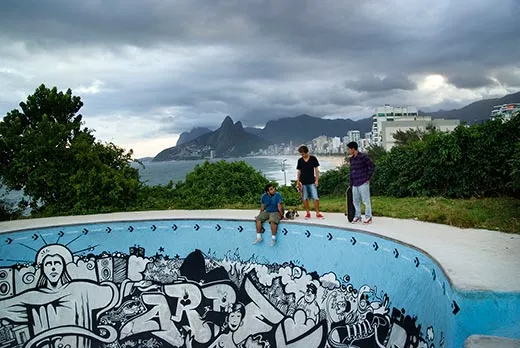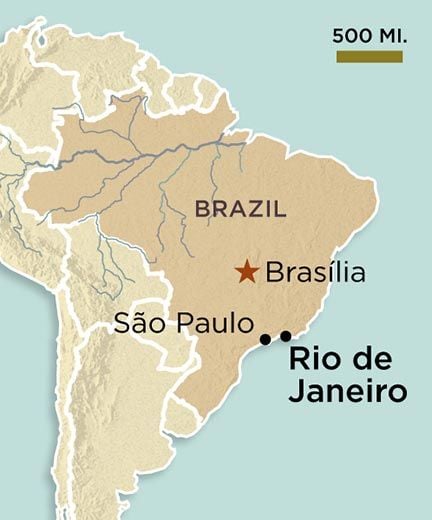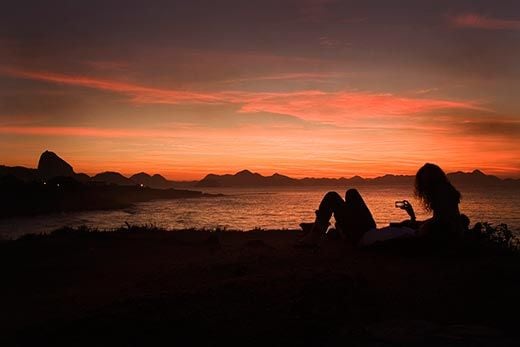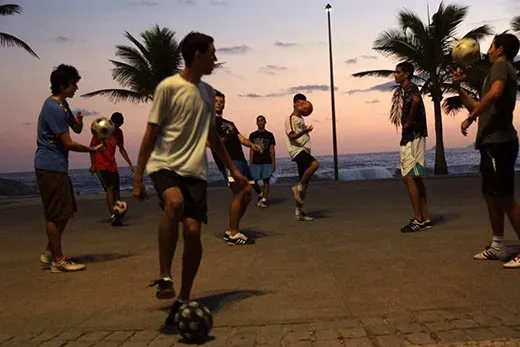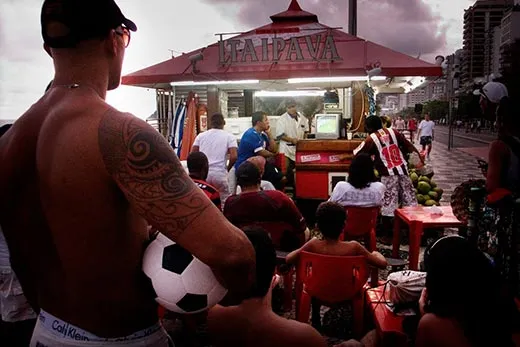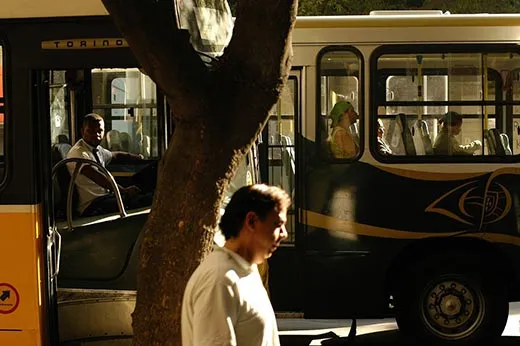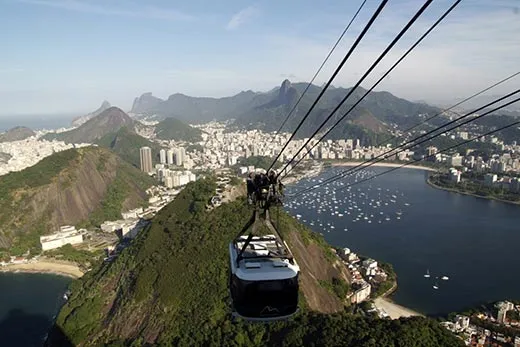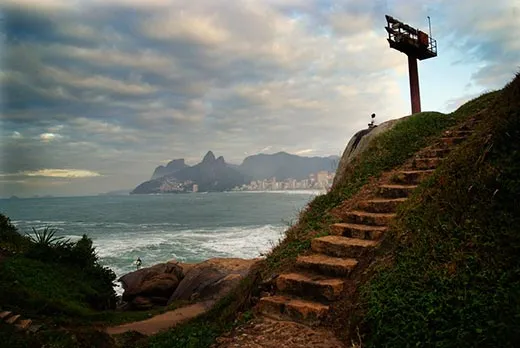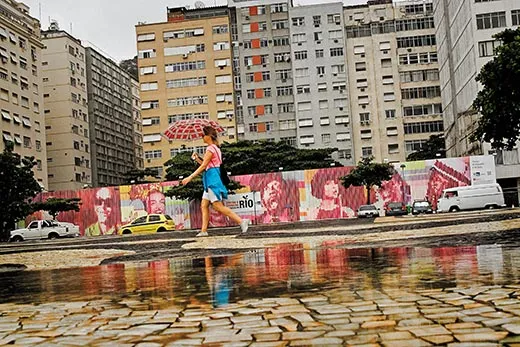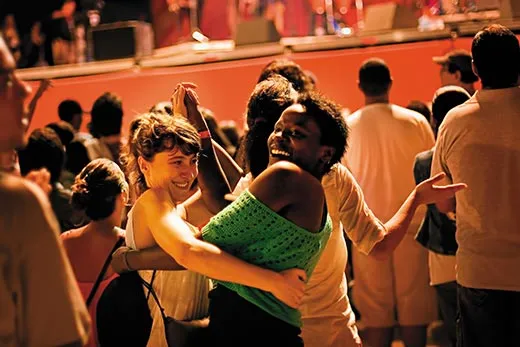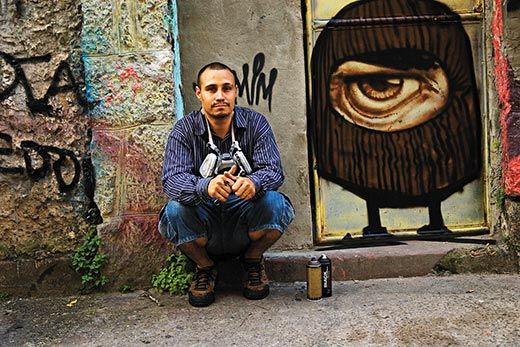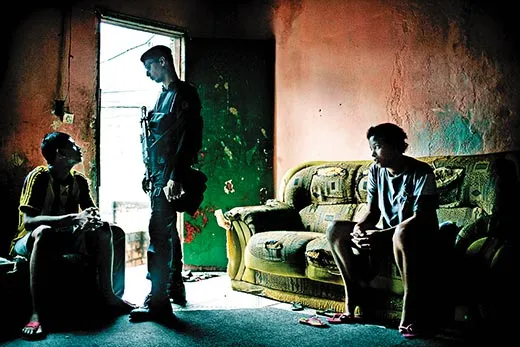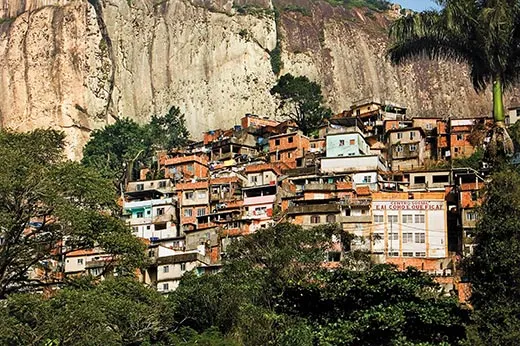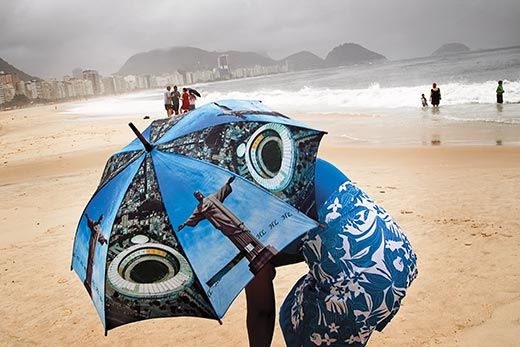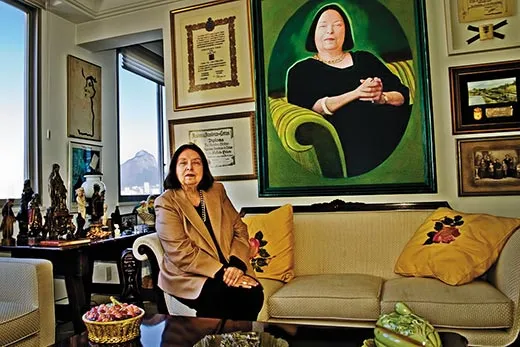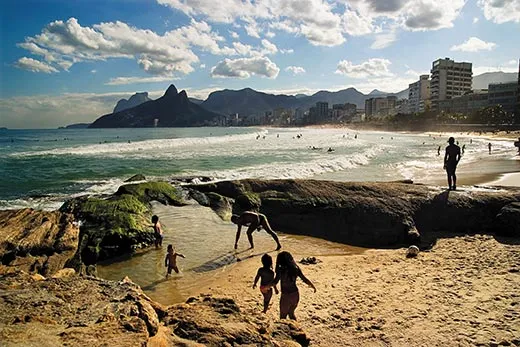Reinventing Rio
The dazzling but tarnished Brazilian city gets a makeover as it prepares for the 2014 World Cup and 2016 Olympic Games
/https://tf-cmsv2-smithsonianmag-media.s3.amazonaws.com/filer/Rio-Ipanema-Leblon-beach-631.jpg)
When it comes to Rio de Janeiro there is no avoiding the obvious. The city may be as famous for its Carnaval, soccer, flesh and fun as it is infamous for its hillside slums and organized crime. Yet its defining feature remains its breathtaking setting. No visitor can ever forget viewing the city from on high for the first time. Even natives—the Cariocas—stand in awe of its grandeur. How could I feel different? I, too, was born there. As a writer friend, Eric Nepomuceno, put it, “only Paris comes close to matching Rio in self-love.”
Mountains rise to the east and west and protrude like giant knuckles from inside the city itself. Stretching to the north is a vast bay, which Portuguese navigators evidently thought was a river when they first sighted it in January 1502. Hence the name Rio de Janeiro (River of January). For centuries, ferries carried people and cargo to and from the city of Niterói on the bay’s eastern shore; today a seven-mile-long bridge crosses the bay. And standing guard at its entrance is the 1,300-foot-high granite mound known as the Pão de Açúcar—the Sugar Loaf.
To the west, two long curving beaches—Copacabana and Ipanema-Leblon—run along the city’s Atlantic shoreline, only to be interrupted by twin mountains, the Dois Irmãos, or the Two Brothers. Behind the beaches lies a glistening lagoon, Lagoa Rodrigo de Freitas, and the Botanical Gardens. From there, thick tropical forest reaches up into the Tijuca National Park, “every square inch filling in with foliage,” as the American poet Elizabeth Bishop put it a half-century ago. And rising 2,300 feet out of this vegetation is still another peak, the Corcovado, or the Hunchback, crowned by the 125-foot-tall—including the pedestal—statue of Christ the Redeemer.
Then there are the less sublime areas. Rio’s North Zone, which begins at the city center and sprawls for miles inland, resembles many cities in developing countries, with crowded highways, run-down factories, crumbling housing projects and many of Rio’s more than 1,000 shantytowns, or favelas, as they’re known. Anyone landing at Antônio Carlos Jobim International Airport (named after the late bossa nova composer) is confronted with this unexpected, dismaying sight as they go to their likely destinations in the South Zone of the city.
Then suddenly another Rio comes into view. The bayside highway curves around the city center before dipping into the majestic Aterro do Flamengo park and sweeping past the Sugar Loaf. It then enters the tunnel leading to Copacabana and the broad Avenida Atlántica, which stretches nearly three miles along the beach. A different route south passes under the Corcovado and reappears beside the Lagoa Rodrigo de Freitas, following its shores to Ipanema-Leblon. (That was my way home when I lived in Rio in the 1980s.)
The Atlantic beaches are the city’s playgrounds, with sunbathers crowding near the waves and soccer and volleyball occupying much of the rest. The beaches are also strikingly heterogeneous: people of all income levels and colors mix comfortably, while women and men of every shape feel free to wear the skimpiest of swimsuits. Actors, journalists, lawyers and the like have their favorite meeting places at beachside cafés selling beer, sodas, coconut milk and snacks. There is even a corridor for cyclists and joggers.
Away from the sea, though, the Copacabana neighborhood looks run-down and its streets are often clogged with traffic. Even the more elegant Ipanema and Leblon, one beach but two neighborhoods, coexist with those hillside favelas, highlighting the gulf between Rio’s rich and poor. During violent storms in April this year it was mainly residents of the favelas who died—251 in greater Rio—as a result of landslides. Favelas are also routinely blamed for drug-related violence and all-too-frequent muggings. With the pleasures of living in the beauteous South Zone, then, comes the need for security.
Farther west, beyond Leblon and a smaller beach called São Conrado, is a third Rio, Barra da Tijuca, with 11 miles of sand and no encroaching mountains. Forty years ago, it seemed an obvious place to accommodate Rio’s growing middle class. But what was intended as a model urban development has become a soulless expanse of apartment blocks, highways, supermarkets and, yes, more favelas, including the one, Cidade de Deus, that gave its name to Fernando Meirelles’ award-winning 2002 movie, City of God.
So, for all their devotion to “the marvelous city,” as they call Rio, Cariocas know full well that their hometown has been in decline. The slide began 50 years ago when Brazil’s capital moved to Brasília. For two centuries before then, Rio was the capital of finance and culture as well as politics. To the rest of the world, Rio was Brazil. But once politicians, civil servants and foreign diplomats moved to the new capital in 1960, São Paulo increasingly dominated the nation’s economy. Even important oil fields off the coast of Rio brought little solace. The state government received a share of royalties, but no oil boom touched the city. Rio was stripped of its political identity but found no substitute. Many Brazilians no longer took it seriously: they went there to party, not to work.
“I’d call Rio a ship adrift,” says Nélida Piñón, a Brazilian novelist. “We lost the capital and got nothing in return. Rio’s narcissism was once a sign of its self-sufficiency. Now it’s a sign of its insecurity.”
Lately, Rio has even fallen behind the rest of Brazil. For the first time in its history, Brazil has enjoyed 16 years of good government, first under President Fernando Henrique Cardoso and now under President Luiz Inácio Lula da Silva, who is to leave office on January 1, 2011. And the result has been political stability, economic growth and new international prestige. But during much of this time, Rio—both the city and the state that carries its name—has been plagued by political infighting, incompetence and corruption. And it has paid the price in poor public services and mounting crime.
Yet, for all that, when I recently returned to Rio, I found many Cariocas full of optimism. The city looked much as it did a decade ago, but the future looked different. And with good reason. Last October, Rio was chosen to host the 2016 Summer Olympics, the first to be held in South America and, after Mexico City in 1968, only the second in Latin America. As if in one fell swoop, Cariocas recovered their self-esteem. Further, Lula’s strong support for Rio’s Olympic bid represented a vote of confidence from Brazil as a whole. And this commitment looks secure with either of the main candidates to succeed Lula in general elections on October 3—Dilma Rousseff, Lula’s hand-picked nominee, and José Serra, the opposition challenger. Now, with federal and state governments pledging $11.6 billion in extra aid to prepare the city for the Olympics, Rio has a unique chance to repair itself.
“Barcelona is my inspiring muse,” Eduardo Paes, the city’s energetic young mayor, told me in his downtown office, referring to how the Catalan capital used the 1992 Summer Olympics to modernize its urban structures. “For us, the Olympics are not a panacea, but they will be a turning point, a beginning of the transformation.” And he listed some upcoming events that will measure the city’s progress: the Earth Summit in 2012, known as Rio+20, two decades after the city hosted the first Earth Summit; the soccer World Cup in 2014, which will take place across Brazil, with the final to be held in Rio’s Maracanã stadium; and the city’s 450th anniversary in 2015.
For the Olympics, at least, Rio need not start from scratch. Around 60 percent of the required sports installations were built for the 2007 Pan American Games, including the João Havelange Stadium for athletics; a swimming arena; and facilities for gymnastics, cycling, shooting and equestrian events. The Lagoa Rodrigo de Freitas will again be used for the rowing competitions and Copacabana for beach volleyball, while the marathon will have numerous scenic routes to choose from. The Rio Olympics Organizing Committee will have a budget of $2.8 billion to ensure every site is in good shape.
But because many competition venues will be a dozen or more miles from the new Olympic Village in Barra da Tijuca, transportation could become an Olympic-size headache. Barra today is linked to the city only by highways, one of which goes through a tunnel, the other over the Tijuca Mountains. While about half the athletes will compete in Barra itself, the rest must be transported to three other Olympic “zones,” including the João Havelange Stadium. And the public has to get to Barra and the other key areas.
To pave the way, the organizing committee is counting on a $5 billion state and municipal investment in new highways, improvements to the railroad system and an extension of the subway. The federal government has also committed to modernize the airport by 2014, a long overdue upgrade.
Yet even if the Olympics are a triumph for Rio, and Brazil does unusually well in medals, there is always the morning after. What will happen to all those splendid sports installations after the closing ceremony on August 21, 2016? The experience of numerous Olympic cities, most recently Beijing, is hardly encouraging.
“We’re very worried about having a legacy of white elephants,” said Carlos Roberto Osório, the secretary general of the Brazilian Olympic Committee. “With the Pan American Games, there was no plan for their use after the games. The focus was on delivering the installations on time. Now we want to use everything that is built and we’re also building lots of temporary installations.”
Rio already has one embarrassing white elephant. Before leaving office in late 2008, César Maia, then the mayor, inaugurated a $220 million City of Music in Barra, designed by French architect Christian de Portzamparc. It is still not finished; work on its three concert halls has been held up by allegations of corruption in construction contracts. Now the new mayor has the unhappy task of completing his predecessor’s prestige project.
At the same time, Paes is looking to finance his own pet project. As part of a plan to regenerate the shabby port area on the Baía de Guanabara, he commissioned Spanish architect Santiago Calatrava, renowned for his sculptural forms, to design a Museum of Tomorrow, which would focus on the environment and, hopefully, be ready for the 2012 Earth Summit. His initial designs were unveiled this past June.
New museums with bold architecture have long been an easy way of raising a city’s profile. Rio’s Modern Art Museum on the Aterro do Flamengo did that in the 1960s. Since the 1990s, Oscar Niemeyer’s UFO-like Contemporary Art Museum in Niterói has been the main reason for tourists to cross the bay. And construction will soon begin on a new Museum of Image and Sound, designed by the New York-based firm Diller Scofidio + Renfro, on Copacabana’s Avenida Atlántica.
Culture is the one area where Rio holds its own in its decades-old rivalry with São Paulo, its larger and far richer neighbor. São Paulo boasts the country’s most important universities, newspapers, publishing houses, recording companies, theaters and concert halls. But Rio remains the cradle of creativity; Brazil’s dominant television network, Globo, is headquartered in the city and employs a small army of writers, directors and actors for its ever-popular soap operas. Also, Globo’s nightly news is beamed across Brazil from its studios in Rio. But more importantly, as “a city that releases extravagant freedoms,” in Piñón’s words, Rio inspires artists and writers.
And musicians, who play not only samba, choro and now funk, but also bossa nova, the sensual jazz-influenced rhythm that gained international fame with such hits as Antônio Carlos Jobim’s “Girl from Ipanema.” One evening, I joined a crowd celebrating the reopening of the three cramped nightspots in Copacabana—Little Club, Bottle and Baccarat—where the bossa nova was born in the late 1950s.
“Rio remains the creative heart of Brazilian music,” said Chico Buarque, who has been one of the country’s most admired singer-composers for over 40 years and is now also a best-selling novelist. São Paulo may have a wealthier audience, he says, “but Rio exports its music to São Paulo. The producers, writers and performers are here. Rio also imports music from the United States, from the Northeast, then makes it its own. Funk, for instance, becomes Brazilian when it is mixed with samba.”
Popular music can be heard across the city, but the downtown neighborhood of Lapa is the new hot spot. In the 19th century, it was an elegant residential district reminiscent of New Orleans and, while its terraced houses have known better days, many have been converted into bars and dance halls where bands play samba and choro and the forró rhythms of northeastern Brazil. In the weeks before the pre-Lenten Carnaval, attention turns to Rio’s escolas de samba, or samba “schools,” which are, in fact, large neighborhood organizations. During Carnaval, the groups compete for the title of champion, taking turns to parade their dancers and colorful floats through a noisy and crowded stadium known as the Sambódromo.
Rio is also a magnet for writers. As a legacy of its years as the country’s capital, the city is still home to the Brazilian Academy of Letters, which was founded in 1897 and modeled on the Académie Française. Among its 40 immortels today are Piñón, the novelists Lygia Fagundes Telles, Rubem Fonseca and Paulo Coelho and the author of popular children’s books, Ana Maria Machado. But even Fonseca’s novels, which are set in Rio’s underworld, rely on São Paulo for their readership.
Except for music, Cariocas are not great consumers of culture. Alcione Araújo, a playwright and lecturer, thinks he knows why. “In a city with these skies, beaches and mountains, it is a crime to lock people inside a theater,” he said. And he might have added movie theaters and art galleries. Walter Moreira Salles Jr., who directed the award-winning movies Central Station and The Motorcycle Diaries, lives in Rio, but looks beyond the city for his audience. A painter friend of mine, Rubens Gerchman, who died in 2008, moved to São Paulo to be close to his market.
But Silvia Cintra, who has just opened a new gallery in Rio with her daughter Juliana, prefers to be close to her artists. “São Paulo has more money, but I think that 80 percent of Brazil’s most important artists live and work in Rio,” she said. “São Paulo treats art as a commodity, while the Carioca buys art because he loves it, because he has passion. Rio has space, oxygen, energy, everything vibrates. The artist can work, then go for a swim. You know, I have never felt as happy about Rio as now.”
Cariocas have long accepted the hillside favelas as part of the landscape. Writing in Tristes Tropiques, French anthropologist Claude Lévi-Strauss described what he saw in 1935: “The poverty-stricken lived perched on hills in favelas where a population of blacks, dressed in tired rags, invented lively melodies on the guitar which, during carnaval, came down from the heights and invaded the city with them.”
Today, although many of Rio’s favelas still lack running water and other basic necessities, many have improved. Brick and concrete houses have replaced wooden shacks, and most communities have shops; many have schools. Until around 20 years ago, the favelas were relatively tranquil, thanks to the power of the bicheiros, godfather-like figures who run an illegal gambling racket known as the “animal game.” Then the drug gangs moved in.
In the late 1980s, Colombian cocaine traffickers opened new routes to Europe through Brazil. Homegrown gangsters stepped in to supply the local market, much of it found among the young and wealthy of the South Zone. Soon, protected by heavy weapons, they set up their bases inside the favelas.
The response of the state government, which is in charge of security, was largely ineffective. Police would carry out raids, engage in furious gun battles with traffickers—kill some, arrest others—then leave. With most drug gangs linked to one of three organized crime groups, Comando Vermelho (Red Command), Amigos dos Amigos (Friends of Friends) and Terceiro Comando Puro (Pure Third Command), favela residents were routinely terrorized by bloody turf wars.
The reputation of Rio’s police was little better. Many were thought to be on the traffickers’ payroll. A December 2009 report by the New York City-based Human Rights Watch accused police officers of routinely executing detainees they claimed had been killed resisting arrest. In some favelas, police have driven out the traffickers—only to set up their own protection rackets.
Fernando Gabeira is one politician with direct experience of urban warfare. In the late 1960s, having joined leftist guerrillas fighting Brazil’s military dictatorship, he participated in kidnapping the American ambassador, Charles Burke Elbrick. Elbrick was released after he was swapped for political prisoners, while Gabeira was himself arrested and then freed in exchange for another kidnapped foreign diplomat. When Gabeira returned to Brazil after a decade in exile, he was no longer a militant revolutionary and soon won a seat in Congress representing the Green Party. Having narrowly lost in Rio’s mayoral elections in 2008, he plans to challenge Sérgio Cabral’s bid for re-election as state governor in October.
“The principal characteristic of the violence is not drugs, but the occupation of territory by armed gangs,” Gabeira said over lunch, still dressed in beach clothes. “You have 600,000 to 1 million people living in favelas outside the control of the government. And this is the state government’s responsibility.” Like many experts, he rejects the automatic link between poverty and violence. “My view is that we should combine social action and technology,” he said. “I suggested we use drones to keep an eye on the traffickers. I was laughed at until they shot down a police helicopter.”
The downing of the helicopter last October took place just two weeks after the city was chosen to host the 2016 Olympics, following Governor Cabral’s assurances to the International Olympic Committee that army and police reinforcements would guarantee the security of athletes and the public. After the helicopter was shot down, Cabral threw his weight behind a new strategy designed by the state’s security secretary, José Beltrame.
Starting in the South Zone, Cabral ordered the state government to establish a permanent police presence—so-called Police Pacification Units—in some favelas. After police were met by gunfire, they began a policy of leaking to the media which favela they would next target, giving traffickers time to leave and, it soon transpired, to invade favelas farther inland.
One morning I visited Pavão, Pavãozinho and Cantagalo, a three-community favela overlooking Copacabana and Ipanema, which has been peaceful since this past December. First settled a century ago, the favela has a population estimated at 10,000 to 15,000. A cable car built in the 1980s takes residents up the slope and returns with garbage in cans. It has a primary school, running water and some drainage. For years, it was also a drug stronghold. “There were constant gun battles,” recalled Kátia Loureiro, an urban planner and financial director of a community organization called Museu de Favela. “There were times when we all had to lie on the floor.”
Today, heavily armed police stand at the favela’s entrance, while others patrol its narrow alleys and steep steps. After visiting the local school and a boxing club, I came across the Museu de Favela, which was founded two years ago to empower favela residents to develop their community and improve living conditions. Even during the bad times, it organized courses to train cooks, waiters, seamstresses, craftsmen and artists. Now it offers tours of its “museum,” which is what it calls the entire favela. Says the group’s executive director, Márcia Souza: “The idea is, ‘My house is in the favela, so I am part of the museum.’”
My visit began with a rooftop performance by Acme, the stage name of a local rapper and Museu founder. “We don’t need more cops,” he told me, “we need more culture, more rap, more graffiti, more dance.” The Museu sees social exclusion, not violence, as the problem in the favelas.
I took the cable car up to the home of Antônia Ferreira Santos, who was selling local handicrafts. She showed me her rooftop garden of herbs and medicinal plants. My final stop was at a little square where 11 boys and 5 girls of the local samba school were practicing drumming. With Carnaval only two weeks away, there was no time to waste.
Just how many of the city’s roughly 1,000 favelas can be “pacified” by 2016 is unclear. Of course if Rio is to fully exploit its potential as a tourist destination, it must do more. It needs an up-to-date airport, better transportation and greater overall security, as well as new hotels and easier access to popular sites like the Corcovado.
One man who believes in getting things done is the city’s new cheerleader, Eike Batista, an oil and mining magnate and reputedly Brazil’s wealthiest man. After working mainly abroad for years, he returned home in 2000 and, unusually for a Brazilian industrialist, chose to live in Rio rather than São Paulo. “I said at the time, ‘I’m going to spend my millions to fix this city,’” he recounted when I called on him at his home overlooking the Botanical Gardens. In a city with little tradition of individual philanthropy, he started by spending $15 million to help clean the lagoon.
In 2008, Batista bought the once-elegant Hotel Glória, which is now undergoing a $100 million makeover. He then acquired the nearby Marina da Glória, a port for leisure boats, and is modernizing it at a cost of $75 million. He is putting up two-thirds of the estimated $60 million it will take to build a branch of a top-flight São Paulo hospital and has invested $20 million in movie productions in Rio. Over a dinner with Madonna last November, he committed $7 million for her children’s charity. He even built his own Chinese restaurant a mile from his home. “It’s difficult to fly to New York once a week to eat well,” he said with a laugh.
So, yes, things are stirring in Rio. Plans and promises are in the air, objectives are being defined and, thanks to the Olympics, a deadline looms to focus the mind. True, not all Cariocas support the Rio Olympics: they fear that massive public works will bring massive corruption. But the countdown has begun and Cariocas have six years to prove they can change their city for the better. When the Olympic flame is lit in Maracanã on August 5, 2016, a verdict will be returned. Only then will they know if the entire exercise was worthwhile.
Alan Riding was the Brazil bureau chief for the New York Times. He now lives in Paris. Eduardo Rubiano Moncada grew up in Cali, Colombia. He travels the world on assignment.
Planning Your Next Trip?
Explore great travel deals
Smithsonian magazine participates in affiliate link advertising programs. If you purchase an item through these links, we receive a commission.
